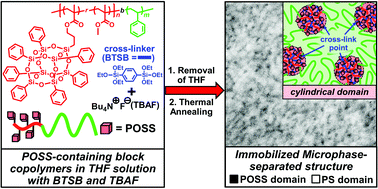Synthesis of diblock copolymers consisting of POSS-containing random methacrylate copolymers and polystyrene and their cross-linked microphase-separated structure via fluoride ion-mediated cage scrambling†
Abstract
Synthesis of a series of diblock copolymers consisting of POSS-containing random methacrylate copolymers and polystyrene (P(MAPOSS-r-methyl methacrylate)-b-polystyrene etc.) has been established by reversible addition–fragmentation chain-transfer (RAFT) polymerisation. The polymerisation of styrene as the second block was well controlled when POSS-containing random copolymers were used as the chain transfer agent (CTA). Dynamic cross-linking of POSS-containing block copolymers, which utilized a cage scrambling reaction among pendant POSS units mediated by a fluoride ion, was achieved by evaporating the solvent from a solution of block copolymers tetrabutylammonium fluoride (TBAF) and 1,4-bis(triethoxysilyl)benzene (BTSB) in THF. During the solvent evaporation and thermal annealing that provided cross-linked polymer films, a phase-separated structure was formed. The microphase-separated structure of the cross-linked block copolymers showed the cylindrical morphology of the POSS-containing blocks, which was proved by small angle X-ray scattering (SAXS) measurements and transmission electron microscopy (TEM) observations. A clear microphase-separated structure was obtained when a larger amount of fluoride ions was used for cage scrambling. The morphology was maintained even after immersing in tetrahydrofuran, indicating that the phase-separated structure was completely immobilized by cross-linking.



 Please wait while we load your content...
Please wait while we load your content...